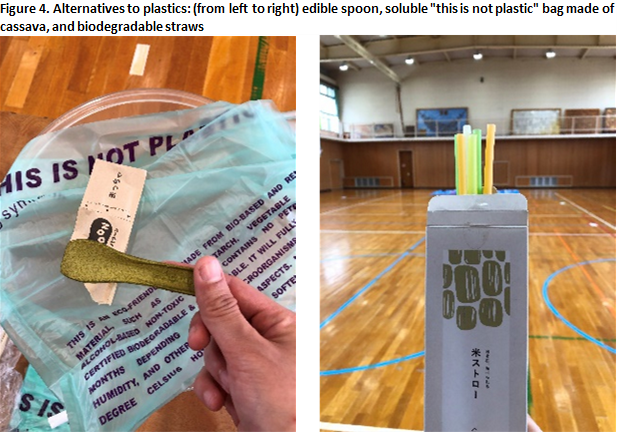The ASEAN-Japan Centre conducted its first Ecoschool class at Yamadaiminami Elementary School in Kishiwada City, Osaka on July 21, in collaboration with the Centre’s ASEAN Class, which aims to introduce ASEAN countries to Japanese students. The Ecoschool class has always been conducted online and this is the first face-to-face class in more than two years since the onset of COVID19 in 2020. Two fellows, Ms. Haruna MASUDA (Japan) and Ms. Yasmin FAUZEE (Malaysia) delivered the lecture to 36 grade 6 students.
The lecture introduced the background of marine plastic waste (MPW), its impact on the environment, the status of the issue in the ASEAN region, as well as the current action against MPW of Kishiwada City. The lesson had an interactive class setting and was divided into 5 activities that encouraged a lot of movement and interaction for the students.

The first activity allowed students to identify and classify the commonly found trash in the sea into five frames; paper, plastic, can/metal, glass, and others. Figure 1 shows the trash distributed on the blue mat that represents the sea, and the 5 frames marked with coloured tape, where students are asked to sort the trash according to its composition (e.g. non-burnable plastic, burnable paper, PET bottles, etc.).

Ms. Masuda and Ms. Fauzee went through each of the frames together with the students and explained about the plastic content of the trash they sorted. They emphasized that plastic could last up to a hundred years in the environment. The students recognized that plastic is incorporated in most objects around them even in unexpected items due to advantageous characteristics of plastic (i.e water-resistant, lightweight etc). In addition, they learned that plastic is not healthy for the environment in the long run.

In the second activity, students were asked to imagine themselves as plastic and to select one among the 3 frames where they think the plastic will end up after final use. The 3 frames were labelled as ‘recycling’, ‘incinerator’ and ‘landfill/environment’. The goal is to expose them to the true state of plastic end-of-life in the world and compare them to Japan. During the activity, 11 students (30.6%) entered the ‘recycle’ frame, 9 students in the ‘incinerator’ (25%) and 16 students (44.4%) in the ‘landfill/environment’ frame. The fellows then compared this to the the real-world distribution: 9 % recycling (3 students), 12 % incinerator (4 students), and 79 % landfill/environment (28 students). Meanwhile, the situation in Japan is different, with 20% recycled, 79% incinerator, and 1% landfill.

In the third activity, the students were asked to reflect on their plastic footprint, and in the fourth activity, they were introduced to plastic alternative products (see figure 4). The activity started by soaking a plastic bag and the “this is not plastic” bag made from cassava in hot water. After stirring for 30 seconds, the “this is not plastic” bag started to disintegrate while the plastic bag remained the same. Next, the students were shown an edible spoon made of wheat and edible straws. To demonstrate that they are not plastic and are actually edible, Ms. Fauzee ate the edible spoon and shared how it tastes like. Then, they soaked the edible straw in hot water until it became soft like spaghetti which can be eaten as well.
Lastly, the two fellows conducted a short presentation which showed the impact of marine plastic pollution on the environment and wildlife, and its presence in the seas and even in the air. They also showed a video of plastic movement in the sea between ASEAN and Japan in which the amount of plastic has increased tremendously over the years.

The fellows also introduced the effort made by Kishiwada city to combat MPW through the Kishiwada Declaration of Zero Plastic Waste. Figure 5 shows Kishiwada City and its several rivers whose water flows from sources such as the Izumi-Katsuragi Mountains and into the sea. Because of this important connection, the city has declared to contribute to the international community and protect the beauty of the area for years to come. Ms. Masuda and Ms. Fauzee encouraged students to take action by river clean-ups or reducing the amount of plastic litter by recycling and reusing plastic waste. They also motivated them to avoid littering and to reduce their use of single-use plastics such as straws and plastic bags. The class ended with a question-and-answer session.
Ms. Masuda and Ms. Fauzee strongly hope that the students could implement the knowledge in their daily life and perhaps inform their family and friends about the seriousness of the issue. Ms. Fauzee shared that the students’ enthusiasm and curiosity moved her as a Fellow as she could see the potential impact it could bring to society. In the end, as an ASEAN citizen living in Japan, it was a great and meaningful experience for her to see this effort to combat the issue of marine plastic waste in the ASEAN region.

